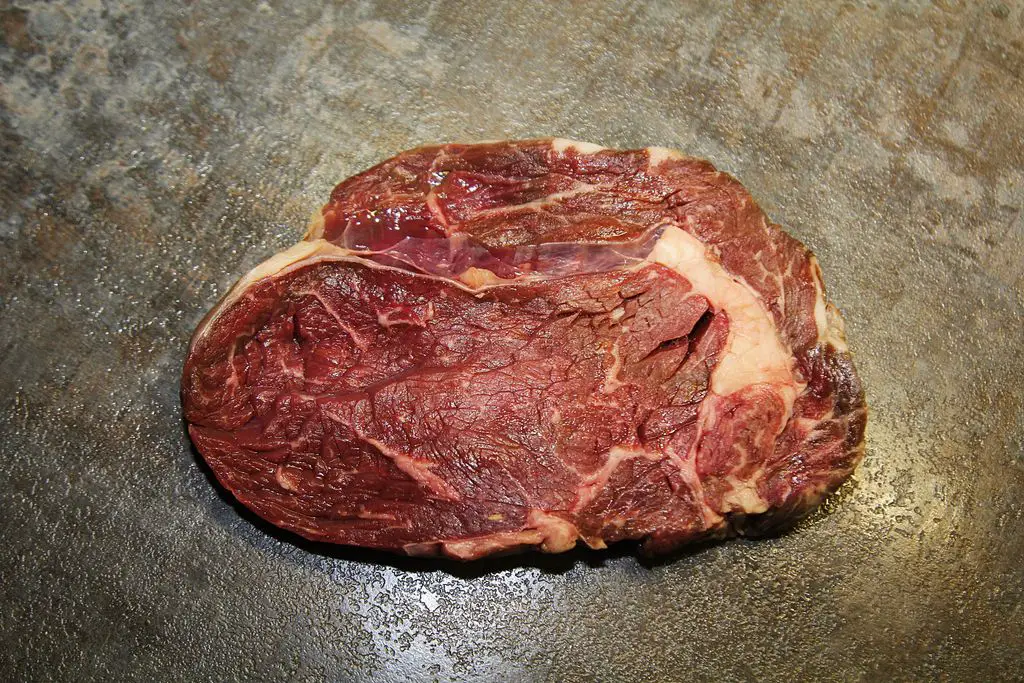Successfully dry-aging steak at home can be tricky at first, but once you know that you’re doing, it’s a breeze!
I am going to tell you some basics on how to dry age a steak at home which will help you achieve a more successful dry-aging steak at home experience.
I have done this multiple times successfully, but knowing why it works is what really gets me excited about cooking.
So, let’s learn how to dry age a steak at home…
Contents
- 1 What Does Dry Aging A Steak Mean?
- 2 How Long Does It Take To Dry Age A Steak At Home?
- 3 What Tools Do I Need To Dry Age A Steak At Home?
- 4 Myths About Dry Ageing Steak At Home
- 5 Steps To Dry Age A Steak At Home
- 6 Why Does Dry Aged Steak Taste Better?
- 7 Other Considerations
- 8 Conclusion
- 9 Other Popular Posts
What Does Dry Aging A Steak Mean?
First, let’s quickly go over what dry aging a steak actually means.
This is a process where a cut of beef is hung in a controlled environment for a period of time.
This allows the moisture to evaporate from the meat, which concentrates the natural flavors and essentially tenderizes it – this makes for a more flavorful steak that melts in your mouth.
It’s typically done commercially with special humidity-controlled rooms, but it can be done at home as well.
To accomplish this at home, you need to find a similar environment that’s dry and cold enough to let the steak dry properly without spoiling.
How Long Does It Take To Dry Age A Steak At Home?
Dry aging steak at home takes roughly around 30 days before you will notice any dry-aging flavors.
However, in my experience, it’s between 60 – 80 days that the steak really comes into its own, developing the rich beefy umami flavors dry aging is famous for.
Be aware that the steak will be riddled with bacteria.
Until modern man discovered how to use refrigerators, all meat was dry-aged this way.
Adding salt to the meat will inhibit bacterial growth and add flavor – if you’re trying to do it at home, I highly recommend it.
What Tools Do I Need To Dry Age A Steak At Home?
Believe it or not, you don’t need any fancy or special tools to dry age steak at home, simply because you should use your refrigerator.
If you’re anything like me, that’s probably already full of beer and leftover takeout.
However, you will need a pan big enough to hold the steak (even as it shrinks as the water evaporates) and some string or butcher twine to hang it from.
Ensure you have saran wrap or cheesecloth to wrap the steak up with too.
I also recommend using a refrigerator thermometer to monitor the temperature, humidity and to ensure it doesn’t go above 55 degrees Fahrenheit.
This is important from a food safety standpoint as refrigerators aren’t as consistent as commercial meat lockers.
Myths About Dry Ageing Steak At Home
Many believe that dry-aging steak is impossible because it’s not cold enough.
This is false, have you heard of the Himalayan Ice Man? He does just fine at freezing temperatures that are much colder than your fridge will be.
The second myth is that dry-aging steak at home will result in freezer burn. This can happen if you leave it for too long, however, in most cases, 30 – 80 days is the ideal time frame for dry aging steak at home.
The third myth is that you need a humidity-controlled room to age steak effectively.
This too is false because all you need to do is wrap it up and seal it away from air and let the water evaporate off naturally.
You can take extra steps to avoid freezer burn by wrapping the steak up in saran wrap or even better, cheesecloth, as tightly as possible.
This blocks out any humidity and keeps the steak fresh longer.
Another myth is that dry-aging steak at home won’t make a difference because you won’t be able to age it long enough.
This is very short-sighted thinking because after aging a steak properly, even for 30 days, you’ll not only notice a more intense flavor but also a significantly reduced cooking loss and overall improved yield.
Steps To Dry Age A Steak At Home
Ok, so how do you actually dry age steak at home? Well, there are a few steps you must take before proceeding.
For one, you need to have a refrigerator large enough to accommodate your steak or at least a tray and some space around it (a lot of refrigerators come with removable shelves which make life very easy).
You’ll also want to cover the bottom of the fridge with brown butcher paper and turn off the air conditioner/dehumidifier settings since dry-aging will naturally produce moisture.
Step 1
The first step is to get your hands on a prime cut of beef and cut it into steaks that will fit your fridge. I usually dry age a small strip steak/tenderloin or ribeye.
You can also go with sirloin if you want because it’s much less expensive, just know that its grain is not as fine due to all the connective tissue which requires more time to soften.
For your first time attempting to dry age steak at home, it’s best to use cheaper cuts to learn the process.
You wouldn’t want to start trying to dry age expensive cuts at first as you may ruin the cut for the first try.
Step 2
Next, unwrap the steak and pat it dry with paper towels.
Do not wash it or you will lose all the natural juices that are forming as we speak which is essential for this process to work.
Step 3
Place a wire rack over a sheet tray and place each steak on top of the wire rack, making sure none of them touch each other.
This may take two sheets or trays if you are planning on dry aging more than one steak at a time.
Step 4
Hang the steaks somewhere that is between 50°F and 60°F.
Most people recommend hanging your meat in your basement or an area of your house that has lower temperatures, but if you live in an area where it never gets cold then a refrigerator will work just fine.
The reason it needs to be somewhere cool is that warm air speeds up the process of spoilage and any bacteria that may be living in your steak will reproduce much faster than they would in cold temperatures.
Commercial dry-aged beef comes from meatpackers who own their own refrigerated warehouses where they can keep meat for longer periods of time without worry.
Step 5
When you’re steak has had time to sit, whether that be for a week or 80 days, take it out of the bag and rinse it off.
At this point, you can either sear it with a blowtorch to create a nice, browned crust on each side or cook it as normal.
Steak can be cooked however you prefer, just remember that dry-aged meat will lose a lot more water than fresh meat so don’t overcook it.
There is a lot of waste in commercial dry-aging operations because there’s no way to maintain consistent aging conditions throughout the huge quantities of meat they process.
Some meat also goes bad before it can be used, further magnifying this issue.
Why Does Dry Aged Steak Taste Better?
Is it really worth going through all of this trouble to dry age your steak at home?
The reason a dry-aged steak tastes so much better is that the process of aging allows enzymes to slowly break down proteins and fats into more flavorful amino acids.
In addition, as meat ages it loses moisture, concentrating its flavor. The melting point of connective tissue in meats is around 54 °C (130 °F), meaning that at room temperature and normal refrigerator temperatures, aged steaks are more tender than fresh cuts.
Size is another factor – a large steak will age faster than a small one per unit of surface area.
This is due to the fact that larger pieces of beef have more juices trapped inside which take longer to escape the meat during aging.
It is absolutely worth going through this process to dry age your steak at home, it tastes much better and doesn’t require any expensive tools or gadgets.
Simply a refrigerator and some household items, as well as your time and patience.
Other Considerations
It’s worth keeping in mind that when dry aging a steak at home, you will probably be losing about 20% to water loss.
However, in my eyes, this is more than worth it as dry age steak tastes incredible!
Not only that but dry-aged steak is also often called ‘butter like’ because of how tender it is.
Dry aging steak at home is not only cheaper but also gives you complete control over the process.
Once you get into dry-aging steak at home, you may never buy another piece of factory-farmed steak again!
Conclusion
In conclusion, dry-aging steak at home is easy, incredibly effective, and safe if you follow the guidelines provided.
You will have complete control over the process and it will be a fun learning experience.
Once you know how to do this yourself it can be done over and over again and costs a fraction of what you would pay in the store.
Thanks for taking the time to read this post and I how you now know how to dry age a steak at home.
Feel free to share this article with someone who may find it valuable!

